Rules to Better Office Operations - 12 Rules
DevOps is about keeping software healthy by releasing often and inspecting stats each day from the live system.DailyOps or ConsultingOps is about managers keeping a consulting company of engineers working well every day.
Your office reflects your business and provides a consistent experience to both current and potential customers. Much like your house, you usually wouldn't invite guests over if your house isn't clean or organized. The same with your office space, you should make sure everyday that if your customers walked in, at any time they would be impressed by your team's professional appearance.
You should have "Daily Office Maintenance: Morning and Evening" checklist.
Below is a sample DailyOps checklist:
- Ensure your office is open and closed on time as per your advertised business hours. The start time of the first and last time should be in sync with your Google Maps account
- Ensure your office is clean and tidy. The first person in should do a walk through to check on the evening cleaner
-
Perform a client ready walk through each day. It is all about the experience.
- Pretend you are a client walking through the office
- Make sure someone is sitting at Reception, ready to welcome clients
- TV monitors, Bots, and other featured office gadgets should be turned on and working
- Marketing material should be present, available, and neatly arranged, where appropriate
- All conference room whiteboards should be clean and clear and conference room tables empty of debris
- All conference room cords should be hidden to the best of ability
- Conference room chairs and furniture should be arranged neatly
- Ensure that everything else in sight would be appropriate to a visiting client.
- Make sure you follow and improve the procedures - speak to whoever is involved in the DailyOps activity, agree and then update the standard
You should ensure that any building related issues are attended to, this can include:
- Any security or access issues
- Any tradespeople or maintenance staff visiting the building
- Issues with internet, utilities such as power/water or trash
- Any body corporate issues or other localized issues
- Contact your financial controller or corporate contact for assistance of to notify them of any issues requiring more detailed attention
Timesheets are essential as they are required to bill clients or to document the work that is done, and record progress against projects. Making sure that timesheets are in on time help keep things running smoothly and prevent major gaps in reporting, billing, or client value.
See Rules to Better Timesheets.
- You should remind your team each week to turn in timesheets as required by the deadline
- Remind your team of the benefits of turning in timesheets early
- If you find there is someone you have to remind constantly, please follow https://www.ssw.com.au/rules/reduce-your-admin/
Communication is key in any business, but what’s most important is that team members are given a voice and encouraged to participate in communications that have an impact on how they work and do business.
See Rules to Better Communication.
- You should ensure that staff know about, respond to, and are included in relevant company communications such as surveys, training, and announcements
- Remind your team of communications that require time sensitive follow-ups
It's been said that in order to succeed you have to show up – nowhere is that more true than the workplace. Knowing where your staff are is paramount.
At the beginning of each day you should:
- Review a staffing report – consider a report in Power BI or a similar tool that shows which of your staff are booked for what activities on any given day
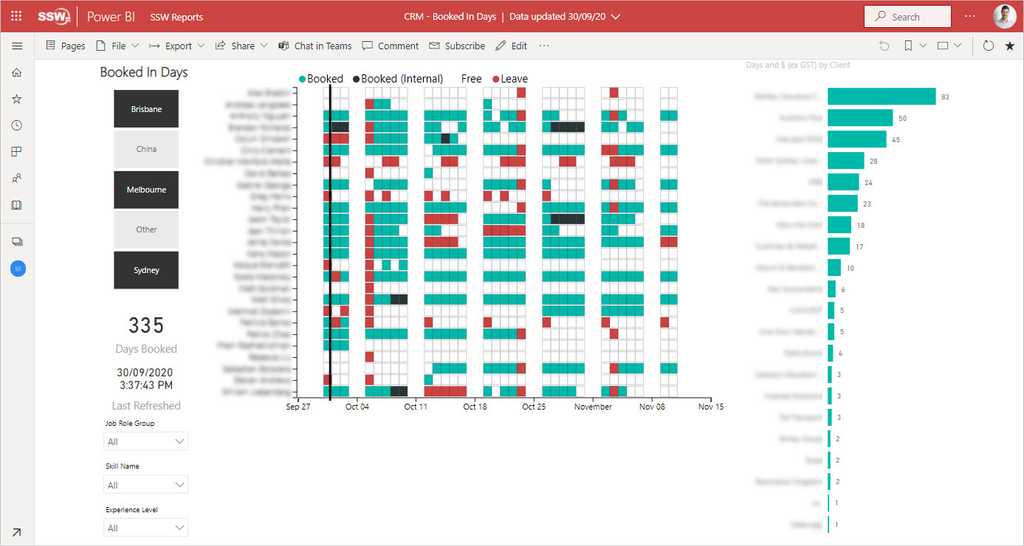
Figure: Green is booked, Black is booked for internal work, and Red is leave - Make updates to staff bookings as required in the source calendars so that the booked in days report is an accurate representation of what clients staff are assigned to. Ensure that any other staffing or service calendars are also updated to accurately reflect the day's planned activities.
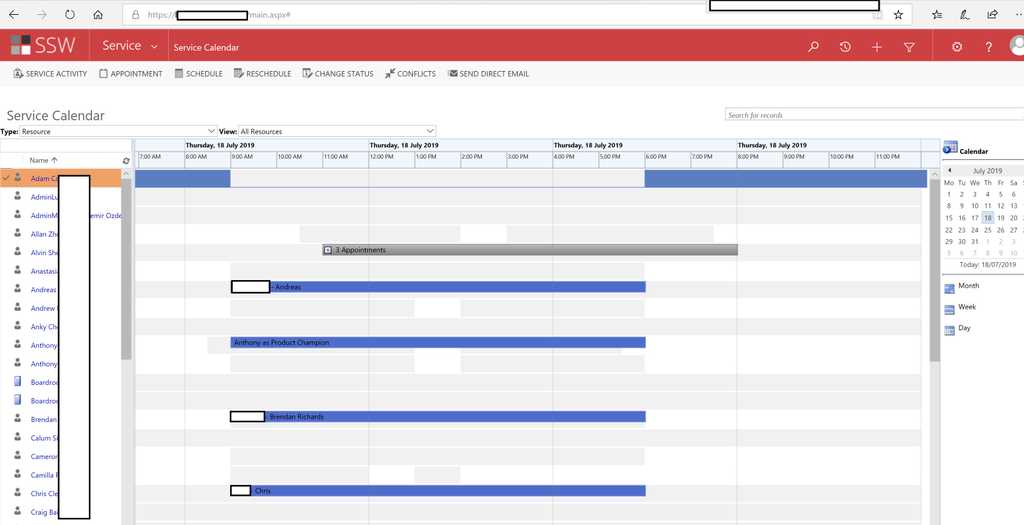
Figure: See 4 blue bars. This means they are booked. Not easy eh! - Review your absence calendar. Each business should have a calendar where employees can note any upcoming absences or leave so that it's easy for other team members to know where folks are at any given time.
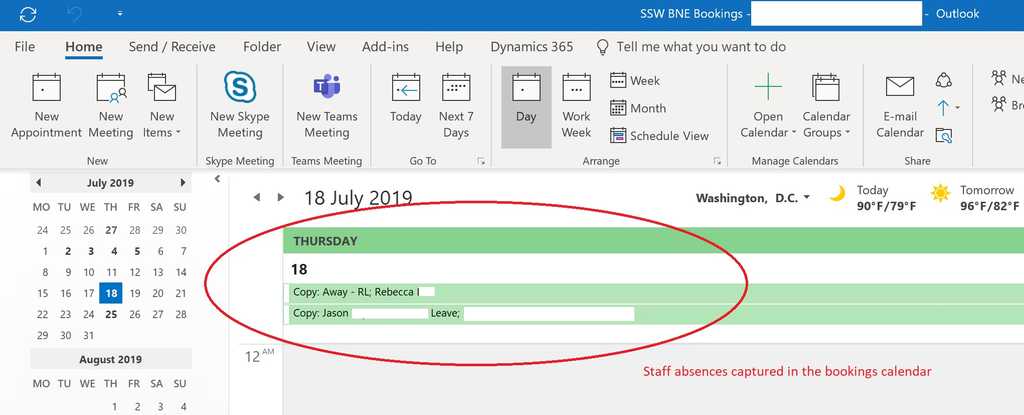
Figure: Here are the 2 people on leave - Check who's in the office. Have a look at who's currently in the office and if someone's not present or doesn't have an absence or booking, find out where they are. You can use a tool like SophieBot or other tools to find out who's physically in your office at any time
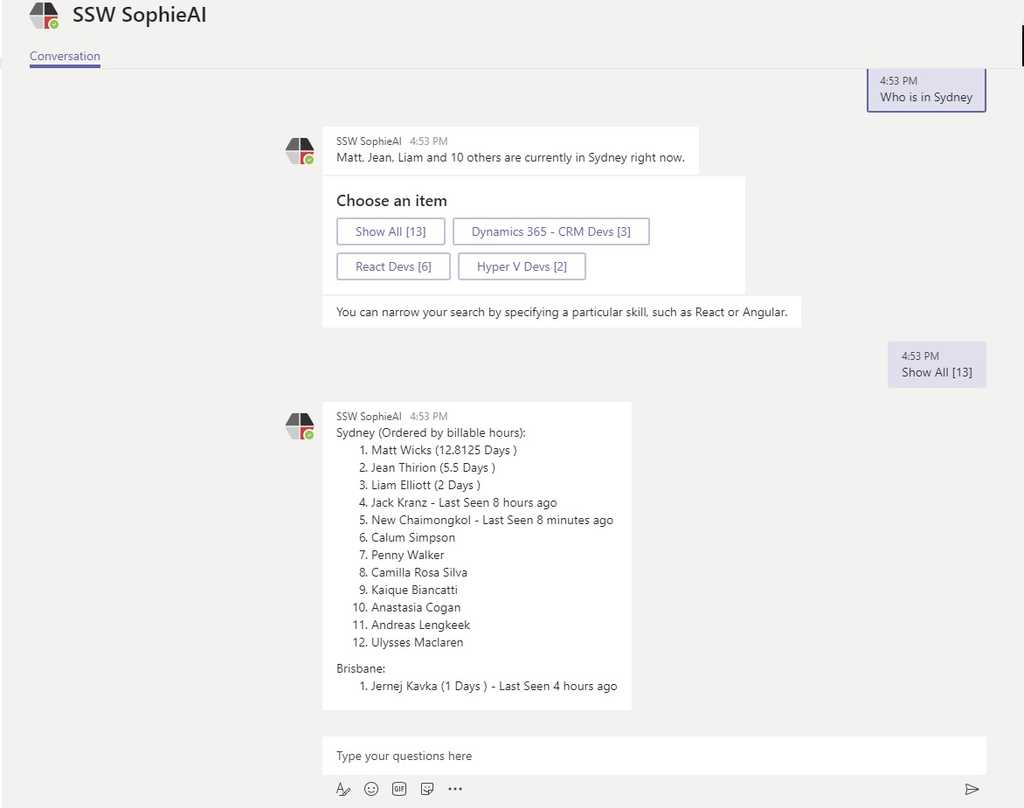
Figure: You can use SophieBot to provide a staffing report of who is physically in the office today 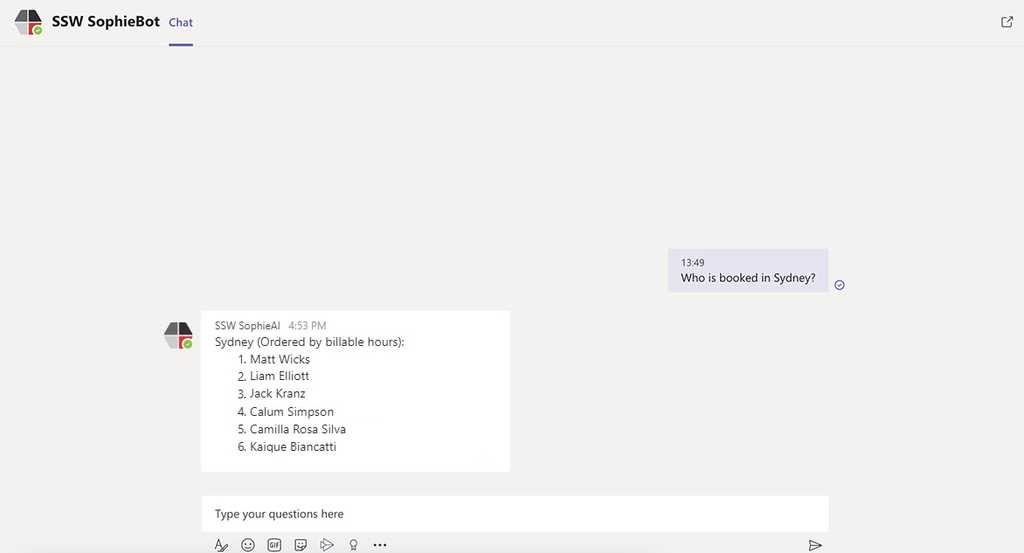
Figure: SSW SophieBot to answer “Who is booked? [ANSWER: 6 people] 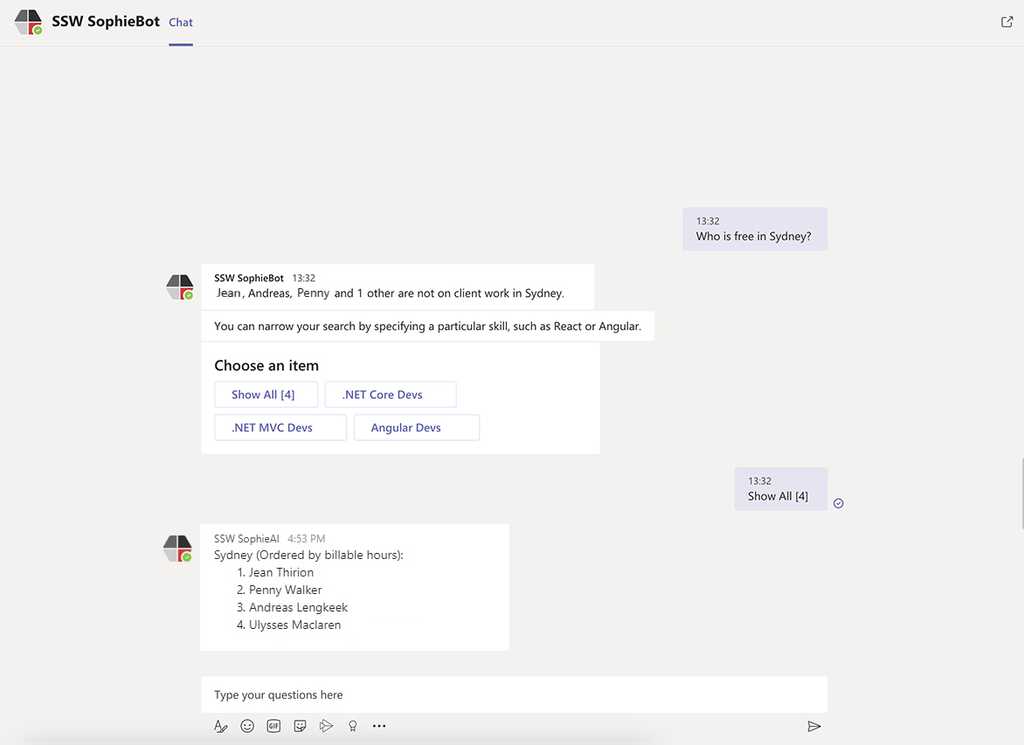
Figure: SSW SophieBot to answer “Who is free? [ANSWER: 4 people] 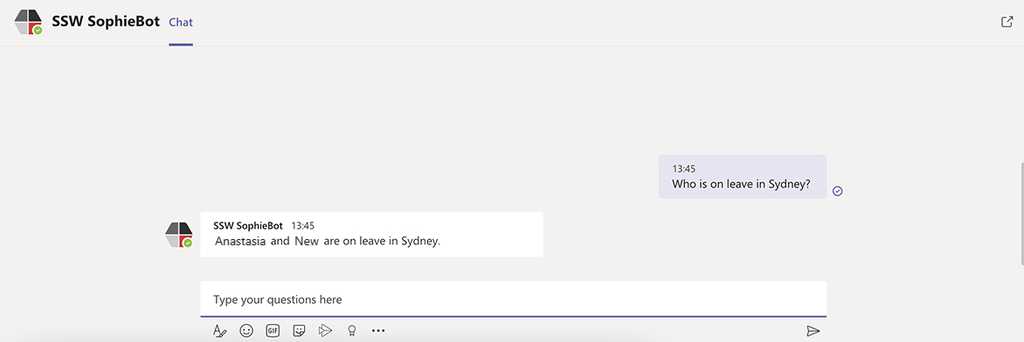
Figure: SSW SophieBot to answer “Who is on leave? [ANSWER: 2 people] - If staff are missing or otherwise unaccounted for, make sure to take appropriate action to find out where they are and why they haven't been in communication
- If you find you are having to constantly remind someone they are missing without the paperwork e.g. on leave with no appointment, WFH with no email, etc. then please follow: https://www.ssw.com.au/rules/reduce-your-admin/
The way you and all members of your team present themselves is a crucial part of creating a good impression for your clients, particularly in their first encounters with you.
Sometimes people may need a reminder to follow the dress code. If you notice someone is not dressed accordingly:
- Speak to them in person or send them a gentle reminder with a link to your dress code. For example; "Hey Bob, I noticed you're wearing blue jeans today and it's a Wednesday. Don't forget we dress our best on a Wednesday because we invite clients in, please avoid wearing those again. Here's the dress code to help you: https://www.ssw.com.au/rules/do-you-have-a-dress-code/
- If there is someone you need to constantly remind, a great way to get them to remember that is causes you pain is to follow our Do you ask your staff to help you reduce your admin? 🙏🏻 rule to help track it and keep them accountable.
A lot of management time is spent chasing people for things like Daily Scrums, wearing the correct attire, and completing their timesheets. Did you know there's an easy way to reduce this admin pain?
Most people miss doing their everyday admin responsibilities not out of spite, but because it's not on the forefront of their minds. They would likely be more mindful if they knew what it costs the company in admin $$ and the Manager in admin pain to chase them.
A great way to remind people of this internal cost is to ask them to help reduce the admin tasks.
There's no harm in reminding people as a one-off, but if you have to do this more than 3 times in a short space of time, it's time to send an email and track it via a tool like SSW Eagle Eye for performance reviews. Doing this gives the behaviour a known consequence which will help reduce the amount of times they do it.
- Send them a friendly reminder on Teams e.g. "Hi Bob, Just a reminder to get your Daily Scrum in for today. It's now late :)"
- If they continue to forget the same thing send an email with the tag (Save me admin 🙏), which can be tracked via Outlook and SSW Eagle Eye
To: {{ STAFF MEMBER }} Cc: Adam Cogan Subject: {{ TASK THEY'VE FORGOTTEN }} (Save me admin 🙏)
Hi {{ NAME OF STAFF }},
We have spoken about this before…
- Please {{ WHAT YOU NEED TO REMIND THEM OF }}
Thanks!
<Sent as per ssw.com.au/rules/reduce-your-admin >
Figure: Good example - Use an email to remind people of repeatedly forgotten tasks
Technology is a fluid industry, with new tools and techniques being developed all the time. To stay ahead of the curve, it is important to continuously learn and improve your skills. This can be done through a variety of methods, such as attending conferences, reading books, watching videos, and participating in online courses.Companies should encourage their employees to continuously learn by providing them with the resources and opportunities to do so.
An example of this is SSW's Chewing the Fat. This is a weekly Microsoft Form that is sent out to all employees educating them on a new topic. This is a great way to keep employees up to date with the latest technologies and trends.It is also an opportunity for employees to share their knowledge and ideas to help improve the company.

Figure: Chewing The Fat - weekly email and form sent to every SSW Employee SSW also gets employees to do at least one induction item per week until there are none left.
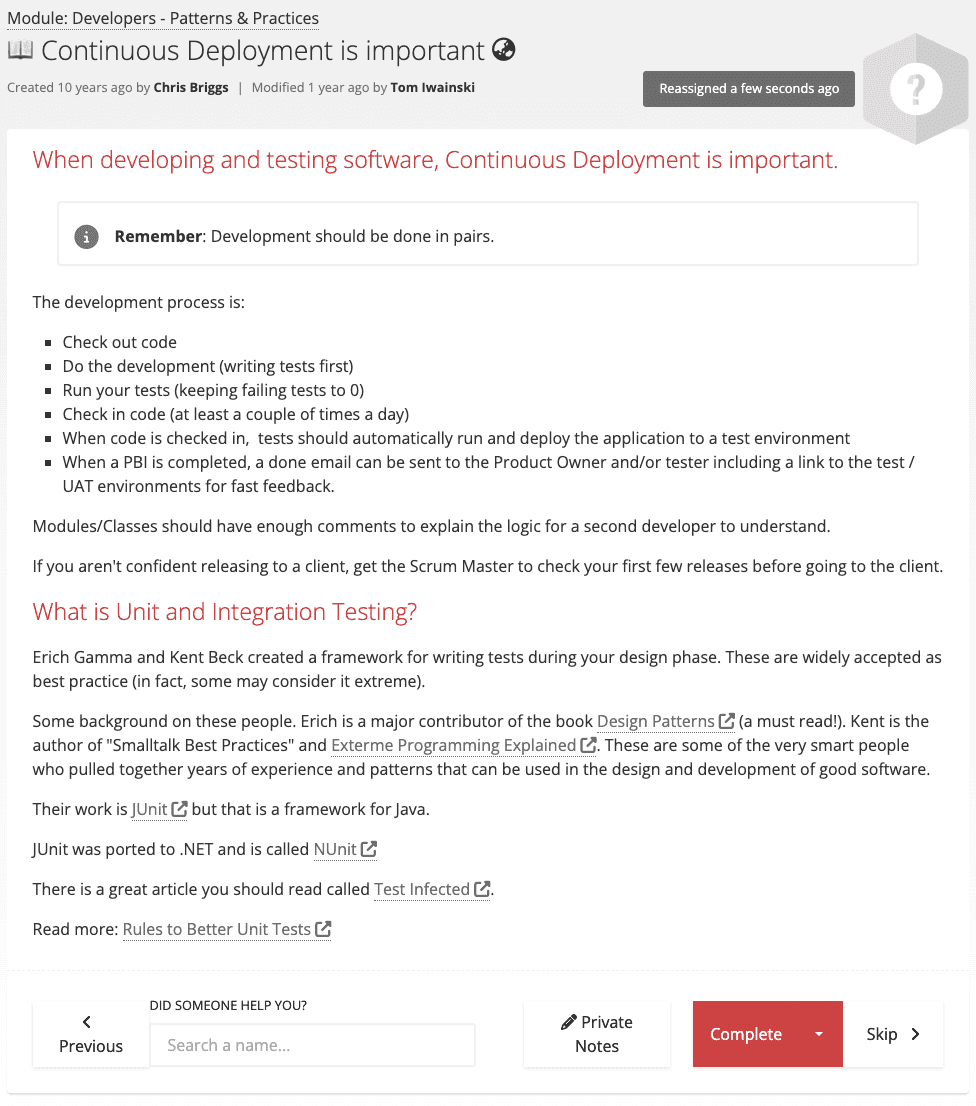
Figure: Every weeks SSWers are encouraged to learn and improve Supporting community and indigenous engagement initiatives is vital for fostering strong relationships with the communities in which we operate. By actively engaging with and supporting local, indigenous, small to medium-sized, and regional businesses, we can promote economic development and sustainability.
Key Principles for Community and Indigenous Engagement
To effectively support community and indigenous engagement initiatives, businesses should focus on the following principles:
Employing Locally
- Local Employment: Prioritize hiring workers with the necessary skills from the host communities where your business operates. This not only provides employment opportunities but also strengthens community ties.
- Indigenous Employment: Create specific programs and opportunities aimed at increasing indigenous employment within your business.
Procuring Locally
- Local Procurement: Whenever possible, source goods and services from local suppliers, especially small to medium-sized businesses and regional businesses. This supports local economies and reduces environmental impact.
- Indigenous Suppliers: Support indigenous-owned businesses by incorporating them into your supply chain wherever possible. This can involve direct procurement or partnerships with larger suppliers to include indigenous businesses.
Community Engagement
- Initiatives and Programs: Where ever appropriate actively participate in and support community and indigenous engagement initiatives. This can include sponsoring local events, participating in community programs, and collaborating with local organizations.
- Feedback and Consultation: Regularly seek feedback from community members and indigenous groups to understand their needs and how your business can better support them.
Practical Implementation Tips
To put these principles into practice, consider the following tips:
- Partnerships: Form partnerships with local organizations, indigenous groups, and business chambers to identify opportunities for engagement and support.
- Training Programs: Develop training programs to enhance the skills of local and indigenous workers, preparing them for employment within your business.
- Mentorship and Support: Provide mentorship and support to local and indigenous businesses, helping them grow and succeed.
- Transparent Reporting: Maintain transparency in your community engagement efforts by reporting on your initiatives and their impacts regularly.
Good and Bad Examples
A company ignores local suppliers and opts for cheaper, distant alternatives, neglecting the potential benefits to the local community.
Figure: Bad Example - Neglecting local suppliers can harm community relationships and economic growth.
A company actively partners with indigenous organizations, hires local workers, and sources materials from small regional businesses.
Figure: Good Example - Supporting local and indigenous communities fosters economic development and strong community ties.
By actively supporting community and indigenous engagement initiatives, businesses can create a positive impact, contributing to the economic and social well-being of the communities in which they operate.
Creating an inclusive, fair, and respectful workplace is essential for the well-being and productivity of employees. Ensuring the protection of fundamental human and labour rights is not only a legal obligation but also a moral imperative that benefits the entire organization.
Key Principles for Respecting and Protecting Human and Labor Rights
To uphold the fundamental rights of all workers, consider the following principles:
Inclusive and Respectful Workplace
- Diversity and Inclusion: Promote a workplace where diversity is respected and valued. Ensure equal opportunities for all workers, regardless of gender, race, religion, age, sexual orientation, pregnancy, parental leave, or disability. https://ssw.com.au/diversity
Freely Chosen Employment
- Voluntary Employment: Ensure all employment is freely chosen. Avoid deceptive recruiting practices and eliminate any form of forced, bonded, or involuntary labour.
Fair Pay and Working Conditions
- Living Wage: Provide fair pay that meets or exceeds a living wage.
- Work Hours: Maintain fair working hours with adequate rest periods to promote work-life balance.
Freedom from Child Labor and Abuse
- Child Labor Prohibition: Do not engage in or support child labour.
- Humane Treatment: Protect workers from harsh or inhumane treatment, including torture, physical and psychological abuse, slavery, servitude, trafficking of persons, or forced marriage.
Freedom to Move and Associate
- Movement and Association: Allow workers the freedom to move and associate, including the right to join or form trade unions (unless prohibited by applicable legislation).
- Identification Documents: Do not require or pressure workers to surrender government-issued identification, passports, or work permits.
Practical Implementation Tips
To ensure these principles are effectively implemented, follow these tips:
- Regular Training: Conduct regular training sessions on diversity, inclusion, and workers' rights.
- Transparent Policies: Establish clear, transparent policies on employment practices, pay scales, working conditions, and grievance mechanisms.
- Monitoring and Audits: Regularly monitor and audit employment practices to ensure compliance with human and labour rights standards.
- Worker Feedback: Encourage and facilitate feedback from workers regarding workplace conditions and practices.
Good and Bad Examples
A company requires all new employees to hand over their passports for "safekeeping" as a condition of employment.
Figure: Bad Example - This practice restricts workers' freedom and can lead to coercion.
A company provides regular training on diversity and inclusion, has transparent policies on fair wages, and offers employees flexible working hours and adequate rest periods.
Figure: Good Example - Promoting a respectful and inclusive workplace with fair pay and working conditions.
By adhering to these principles and practices, organizations can ensure they are respecting and protecting the fundamental human and labor rights of their workers, creating a positive and productive work environment.
Ensuring health and safety in the workplace is a fundamental responsibility for all businesses. A commitment to health and safety not only protects workers but also fosters a positive and productive work environment. This commitment should be evident in all aspects of business operations, from adhering to safety standards to promoting a culture of safe behavior.
Key Principles for Health and Safety Commitment
To effectively demonstrate a commitment to health and safety, businesses should focus on the following principles:
Adherence to Health and Safety Standards
- Compliance: Follow all relevant health and safety standards, policies, and procedures that apply to your work.
- Training: Provide regular training to ensure all employees are aware of and understand these standards and procedures.
Safe and Healthy Workplace
- Workplace Safety: Ensure that the workplace is safe and healthy for all employees. This includes maintaining clean, hazard-free environments and providing necessary safety equipment.
- Care for All Impacted: Extend care to the workers, communities, and customers affected by your business activities. Regularly assess and mitigate any potential risks they may face.
Promoting Safe Behaviour
- Recognition: Recognize and reward safe behaviour among employees. Encourage a culture where safety is prioritized and celebrated.
- Information Sharing: Share information on safety practices and incidents to prevent unsafe behaviour. Promote open communication about health and safety concerns.
Practical Implementation Tips
To put these principles into practice, consider the following tips:
- Regular Safety Audits: Conduct regular safety audits and inspections to identify and address potential hazards.
- Employee Engagement: Involve employees in safety planning and decision-making processes. Encourage them to report safety concerns without fear of retribution.
- Safety Drills: Organize regular safety drills to ensure everyone knows how to respond in case of emergencies.
- Health Programs: Implement health programs that promote physical and mental well-being, such as fitness activities, counselling services, and health screenings.
Handling Workplace Concerns
SSW strives to maintain an open, warm, and healthy workplace culture. However, if issues arise, it is crucial to address them promptly and effectively:
- Raise Concerns Promptly: If you have any workplace concerns, conflict, or problems, no matter how small, raise them as quickly as possible.
- Speak to Your Manager: Initially, bring up concerns with your State Manager. If you are uncomfortable doing so, speak with one of the other State Managers or directly with Adam Cogan.
- Confidential Handling: Any concerns raised will be dealt with in confidence. If the issue is not resolved, re-raise your concerns with another State Manager.
- Document Decisions: If a decision doesn't go your way, send a "for the record" email to confirm.
Emergency Procedures
Fire Procedures
In the event of a fire:
- Critical Fire: Evacuate the building, call 000, and identify the building.
- Non-critical Fire: Use a fire blanket for electrical fires or a fire extinguisher for non-electrical fires, if safe to do so, and call 000.
Health and Medical Conditions
Inform SSW of any medical conditions, illnesses, or diseases to protect other staff. Provide a current medical certificate if applicable.
To: [email protected] Cc: Adam Subject: {{ YOUR NAME }} - My medical conditions (Medical Certificate attached) Attached is my Medical Certificate.
Figure: Email to send if you have any medical condition we should be aware of
COVID-19/Coronavirus Workplace Practices
Follow local and state government COVID-19 safety recommendations. Inform SSW and colleagues if you test positive for COVID-19 and follow isolation guidelines.
Smoking and Drinking Policies
- No Smoking: Smoking is not permitted in SSW offices/cars or client's offices/cars.
- No Drinking: No drinking during the day and no drinking at SSW events.
Discrimination
SSW does not tolerate discrimination based on race, religion, gender, disability, marital status, sexual orientation, national origin, or age.
First Aid
Know the location of the first aid kit in your office. For example:
- Sydney: Near "The Engine," outside the "GitHub" toilets.
- Brisbane: In the kitchen to the left of the fridge.
- Melbourne: In the equipment drawers next to the kitchen.
- Newcastle: In the large cupboard to the right of the fire escape.
Good and Bad Examples
A company neglects to provide necessary safety training to its employees, leading to frequent workplace accidents.
Figure: Bad Example - Lack of safety training results in increased workplace accidents.
A company conducts regular safety audits, provides comprehensive training, and rewards employees for reporting safety hazards and following safety protocols.
Figure: Good Example - Proactive approach to safety ensures a safe working environment.
By consistently demonstrating a commitment to health and safety, businesses can protect their employees, enhance productivity, and build a reputation as a responsible and caring organization.
Adopting best practices for environmental sustainability is essential for software companies to minimize their ecological footprint and promote a greener future. Here are key strategies that software companies, like SSW, can implement to promote environmental sustainability within their operations.
1. Implement Paperless Operations
Reducing paper usage is a simple yet effective way to minimize environmental impact.
- Digital Communication: Use email, chat applications, and project management tools instead of printed documents.
- Electronic Signatures: Adopt electronic signature solutions to eliminate the need for printing contracts and agreements.
- Cloud Storage: Store and share documents using cloud-based services to avoid printing and physical storage.
"Switching from printed reports to digital reports can save significant amounts of paper annually."
Figure: Good Example - Utilizing digital reports to reduce paper consumption.
2. Promote Recycling and Waste Reduction
Set up a comprehensive recycling program in the office to manage waste effectively.
- Recycling Stations: Install clearly labelled recycling bins for paper, plastic, glass, and e-waste throughout the office.
- Reusable Items: Encourage employees to use reusable water bottles, coffee cups, and office supplies.
- E-Waste Disposal: Partner with certified e-waste recyclers to properly dispose of electronic equipment.
"Providing accessible recycling bins for various materials encourages employees to recycle more."
Figure: Good Example - Effective recycling setup in the office.
3. Adopt Energy-Efficient Practices
Energy conservation helps reduce the environmental footprint and operational costs.
- Power Management: Configure computers and office equipment to enter sleep mode when not in use.
- Energy-Efficient Lighting: Replace traditional light bulbs with LED lights to lower energy consumption.
- Remote Work: Encourage remote work to reduce commuting and office energy usage.
"Using LED lighting can significantly cut down on the office’s electricity bills."
Figure: Good Example - LED lighting implementation for energy efficiency.
4. Utilize Cloud-Based Solutions
Cloud-based solutions are typically more energy-efficient than traditional physical servers.
- Server Optimization: Implement efficient server solutions that can reduce energy consumption.
- Scalability and Efficiency: Use cloud platforms that allow for scalability, reducing unnecessary energy use.
- Virtual Meetings: Opt for virtual meetings instead of in-person ones to cut down on travel and associated emissions.
"Moving to cloud-based servers can help reduce energy use by optimizing resource allocation."
Figure: Good Example - Cloud-based solutions reducing energy consumption.
5. Encourage Sustainable Practices Among Employees
Promote sustainability practices that employees can adopt both at work and home.
- Minimize Power Usage: Remind employees to turn off equipment and lights when not in use.
- Use Public Transport or Carpool: Encourage the use of public transport, biking, or carpooling to reduce carbon emissions.
- Sustainability Initiatives: Support and participate in local sustainability and environmental initiatives.
6. Continuously Explore New Sustainability Opportunities
Stay proactive in finding new ways to enhance sustainability practices.
- Regular Audits: Conduct regular audits to identify areas for improvement in sustainability practices.
- Green Certifications: Pursue green certifications to demonstrate commitment to environmental sustainability.
- Community Engagement: Engage with the community to support broader environmental initiatives and share best practices.
By adopting these best practices, software companies can significantly reduce their environmental impact and lead by example in promoting sustainability.